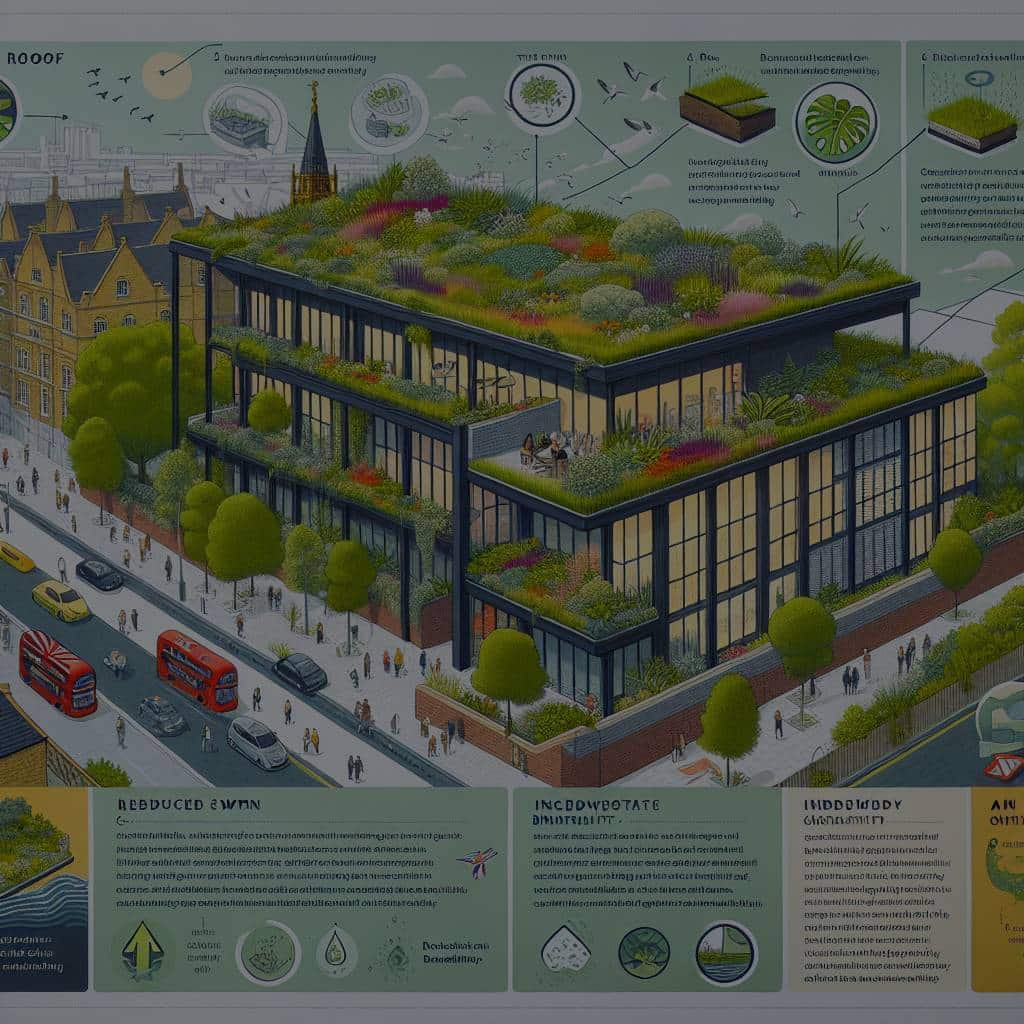In a world increasingly conscious of our environmental footprint, green roofs are emerging as a key component in urban design for cities striving to be environmentally friendly. Over the recent years, they have gained popularity due to their numerous benefits, including sustainable energy production, improved air quality, thermal regulation, and enhancement of urban spaces. This article explores the potential of green roofs within the context of urban planning in the United Kingdom, focusing on how they can contribute to building more sustainable and climate-resilient cities.
Understanding the Concept of Green Roofs
Before we delve into the process of implementing green roofs, it’s critical to understand what they are and how they function. Green roofs, also known as living roofs, are roofs of buildings that are partially or completely covered with vegetation and a growing medium, planted over a waterproofing membrane. They may also include additional layers such as a root barrier and drainage and irrigation systems.
In the same genre : What Are the Latest Advances in Electric Vehicle Battery Technology in the UK?
Green roofs are not just about aesthetics or adding a touch of nature to the urban landscape. They are part of a larger movement towards more sustainable and environmentally friendly cities. With the right design and materials, they can provide numerous environmental benefits, contributing to a healthier and more sustainable urban environment.
Environmental Benefits of Green Roofs
The environmental benefits of green roofs are manifold. They range from improving air quality to reducing energy consumption and enhancing biodiversity in urban areas. To fully appreciate the role of green roofs in urban planning, it’s necessary to delve into these benefits.
Additional reading : What Are the Legal Implications of AI Contracts in the UK Business Sector?
To begin with, green roofs play a significant role in improving air quality. The vegetation on green roofs absorbs airborne pollutants and atmospheric deposition, and filters noxious gases, acting as a sink for carbon, aiding in the reduction of greenhouse gases.
Moreover, green roofs are a sustainable solution to manage water in cities. They retain rainwater, and moderate its release back into the environment, reducing the risk of flooding and sewer overflow.
In terms of energy use, green roofs provide natural insulation. The layer of vegetation and the growing medium prevent heat from escaping during the colder months and absorb the sun’s rays in the warmer months, leading to a decrease in energy use for heating and AC systems.
Designing and Installing Green Roofs
Transitioning from conventional roofs to green roofs requires thoughtful planning and design. Key considerations include the structural capacity of existing buildings, selection of appropriate vegetation, drainage needs, and ongoing maintenance procedures.
The first step in designing a green roof is assessing the load-bearing capacity of the building. It is crucial to ensure that the structure can support the weight of the green roof, including the soil, plants, and water.
Plant selection is another vital aspect. The choice of plants depends on multiple factors such as the climate, the roof’s exposure to sunlight, wind, and the intended purpose of the roof. Ideally, the vegetation should be native to the area, drought-tolerant, and low-maintenance.
Drainage is a critical component of any green roof. A good drainage system will prevent waterlogging and ensure the health and longevity of the roof.
Lastly, while green roofs require less maintenance than conventional gardens, periodic checks and upkeep are necessary to keep the roof healthy and functional.
Green Roofs and Urban Planning
Green roofs can be a significant component of urban planning strategies aimed at creating more sustainable and climate-resilient cities. They can be integrated into a range of urban settings, from residential buildings to commercial structures, contributing to the enhancement of urban spaces.
Green roofs can play a crucial role in mitigating the urban heat island effect – the phenomenon where urban areas are significantly warmer than their surrounding rural areas due to human activities. By absorbing heat and acting as insulators for buildings, green roofs can help to reduce the overall temperature in cities.
Incorporating green roofs into urban planning can also contribute to improved mental wellbeing for city dwellers. The presence of green spaces in urban areas has been linked with reduced stress levels, improved mood, and better cognitive function.
Policies and Incentives for Green Roofs
Pushing for the widespread adoption of green roofs requires supportive policies and incentives. Governments and city administrations can play a key role in encouraging the implementation of green roofs in new buildings and retrofitting them in existing ones.
In the UK, there are already examples of cities taking the lead in promoting green roofs. London, for instance, has policies in place to encourage the use of green roofs in new developments. The city’s ‘London Plan’ stresses the importance of urban greening and specifically references green roofs as a tool for achieving this.
Financial incentives can also significantly boost the adoption of green roofs. This could be in the form of tax breaks or subsidies for building owners who install green roofs.
Providing technical assistance and training for architects, contractors, and building owners can also boost the adoption of green roofs. This would equip individuals with the necessary skills and knowledge to design, install, and maintain green roofs.
Green roofs represent a holistic approach to urban planning, providing environmental, economic, and social benefits. With thoughtful design, careful implementation, and supportive policies, they can make a significant contribution to the creation of more sustainable and environmentally friendly cities in the UK and beyond.
The Impact of Green Roofs on Climate Change and Biodiversity
Green roofs are proven allies in the fight against climate change. By mitigating urban heat islands and reducing energy consumption, they contribute to the reduction of carbon emissions significantly. They capture and store carbon dioxide, a primary greenhouse gas, thereby acting as a carbon sink. This not only combats global warming but also improves air quality in urban areas.
Research indicates that using green roofs can reduce the cooling load of a building by 50-90%, leading to substantial energy savings and reduction of harmful emissions. According to a study published on Google Scholar, a green roof of just 1,000 square feet can absorb the same amount of carbon dioxide emitted by a car driven for 11,000 miles. This demonstrates the potential of green roofs in mitigating climate change impacts.
Green roofs also contribute significantly to enhancing biodiversity in built environments. Urban greening initiatives like green roofs create habitats for various species of insects, birds, and other wildlife, fostering biodiversity in cities where green spaces are often limited. They can serve as stepping stones providing food and shelter for city-dwelling wildlife and migrating species, thus promoting an ecological balance in urban areas.
Green Walls: A Complementary Approach to Green Roofs
While green roofs are a fantastic start, for a comprehensive and effective urban greening strategy, they can be complemented with green walls. Also known as living walls, these are walls covered with vegetation, either directly planted in a growing medium attached to the wall or through the use of modular systems.
Green walls share many of the benefits of green roofs, including air purification, energy savings, and urban heat island mitigation. In addition, they provide opportunities for urban farming and help reduce noise pollution. Green walls, like green roofs, contribute to the aesthetic appeal of the built environment and improved mental well-being of urban dwellers.
Implementing green walls along with green roofs can maximize the availability of green space in urban areas without the need for additional ground-level space. Together, they represent a robust nature-based solution to the challenges of urbanization and climate change.
Conclusion: Towards Eco-Friendly and Sustainable Urban Planning in the UK
Green roofs, complemented by green walls, can play a crucial role in transforming UK’s urban planning towards increased sustainability and eco-friendliness. By mitigating the impacts of climate change, enhancing biodiversity, reducing energy consumption, and improving the quality of life in urban areas, they contribute significantly to the creation of green, resilient cities.
However, to realize their full potential, it’s essential to have supportive policies, financial incentives, and technical assistance in place. By providing tax breaks or subsidies, the government can encourage more building owners to adopt these nature-based solutions. Furthermore, offering training for architects, contractors, and building owners can ensure the effective design, installation, and maintenance of green roofs and walls.
In conclusion, green roofs and green walls represent a holistic and sustainable approach to urban planning. They demonstrate how we can harmoniously integrate the built environment with nature, making our cities not only more sustainable but also healthier and more enjoyable places to live. The journey towards environmentally friendly cities in the UK and beyond demands concerted efforts, innovative solutions, and a commitment to sustainability – and green roofs and walls are a significant step in the right direction.











